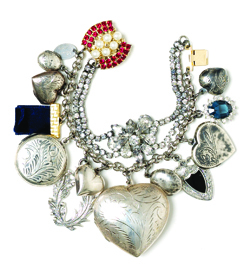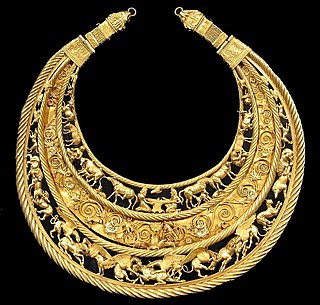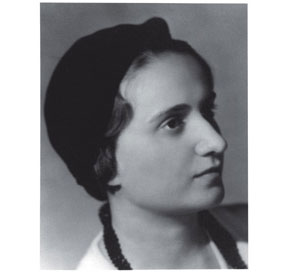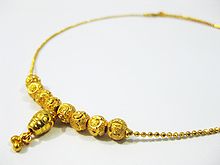
Jewellery consists of decorative items worn for personal adornment, such as brooches, rings, necklaces, earrings, pendants, bracelets, and cufflinks. Jewellery may be attached to the body or the clothes. From a western perspective, the term is restricted to durable ornaments, excluding flowers for example. For many centuries metal such as gold often combined with gemstones, has been the normal material for jewellery, but other materials such as glass, shells and other plant materials may be used.

A necklace is an article of jewellery that is worn around the neck. Necklaces may have been one of the earliest types of adornment worn by humans. They often serve ceremonial, religious, magical, or funerary purposes and are also used as symbols of wealth and status, given that they are commonly made of precious metals and stones.

A brooch is a decorative jewellery item designed to be attached to garments, often to fasten them together. It is usually made of metal, often silver or gold or some other material. Brooches are frequently decorated with enamel or with gemstones and may be solely for ornament or serve a practical function as a clothes fastener. The earliest known brooches are from the Bronze Age. As fashions in brooches changed rather quickly, they are important chronological indicators. In archaeology, ancient European brooches are usually referred to by the Latin term fibula.

Wearable art, also known as Artwear or "art to wear", refers to art pieces in the shape of clothing or jewellery pieces. These pieces are usually handmade, and are produced only once or as a very limited series. Pieces of clothing are often made with fibrous materials and traditional techniques such as crochet, knitting, quilting, but may also include plastic sheeting, metals, paper, and more. While the making of any article of clothing or other wearable object typically involves aesthetic considerations, the term wearable art implies that the work is intended to be accepted as an artistic creation or statement. Wearable art is meant to draw attention while it is being displayed, modeled or used in performances. Pieces may be sold and exhibited.

An anklet, also called ankle chain, ankle bracelet or ankle string, is an ornament worn around the ankle. Barefoot anklets and toe rings historically have been worn for at least over 8,000 years by girls and women in Indus Valley, in South Asia where it is commonly known as pattilu, payal, golusu and sometimes as nupur. They have also been worn by Egyptian women since predynastic times. In the United States both casual and more formal anklets became fashionable from the 1930s to the late–20th century. While in Western popular culture both younger men and women may wear casual leather anklets, they are popular among barefoot women. Formal anklets are used by some women as fashion jewellery. Anklets are an important piece of jewellery in Indian marriages, worn along with saris.

A charm bracelet is a type of bracelet which carries personal jewelled ornaments or "charms", such as decorative pendants or trinkets. The decorative charms usually carry personal or sentimental attachment by the owner.

Jewellery as an art form originated as an expression of human culture. Body ornamentation, one purpose of jewellery, has been known since at least the Stone Age. The history of jewellery in Ukraine reflects the influence of many cultures and peoples who have occupied the territory in the past and present.

Kenneth Jay Lane was an American costume jewelry designer.

Hairwork, or jewelry or artwork made of human hair, has appeared throughout the history of craft work, particularly to be used for private worship or mourning. From the Middle Ages through the early twentieth century, memorial hair jewelry remained common. Hair, considered to be a remnant off the person it was cut from, also has often played a part in myths and legends; in a Swedish book of proverbs, one can read that “rings and bracelets of hair increase love”. One example can be found in Denmark, at Rosensborg’s palace, which is a bracelet of precious metal with a simple braided lock of hair - a gift from King Christian IV (1577-1648) to his queen. Another example would be the rings commemorating the execution of King Charles I of England (1600-1649), which circulated among his faithful supporters. Other famous people who owned hair jewelry include Napoleon, Admiral Nelson, Queen Victoria and her large family, Christina Nilsson and Jenny Lind.
Dorrie Nossiter was an English jeweller and jewellery designer from Aston, near Birmingham.

Alexis Kirk was an American jewelry designer who also designed clothing and fashion accessories.

Miriam Haskell was an American designer of costume jewelry. With creative partner Frank Hess, she designed affordable pieces from 1920 through the 1960s. Her vintage items are eagerly collected and the namesake company, which first displayed her jewelry in New York City's McAlpin Hotel, continues. It is currently listed as Haskell Jewels, LLC.

Ancient Egyptian clothes refers to clothing worn in ancient Egypt from the end of the Neolithic period to the collapse of the Ptolemaic Kingdom with the death of Cleopatra in 30 BC. Egyptian clothing was filled with a variety of colors. Adorned with precious gems and jewels, the fashions of the ancient Egyptians were made for not only beauty but also comfort. Egyptian fashion was created to keep cool while in the hot desert.

The Middle Ages was a period that spanned approximately 1000 years and is normally restricted to Europe and the Byzantine Empire. The material remains we have from that time, including jewelry, can vary greatly depending on the place and time of their creation, especially as Christianity discouraged the burial of jewellery as grave goods, except for royalty and important clerics, who were often buried in their best clothes and wearing jewels. The main material used for jewellery design in antiquity and leading into the Middle Ages was gold. Many different techniques were used to create working surfaces and add decoration to those surfaces to produce the jewellery, including soldering, plating and gilding, repoussé, chasing, inlay, enamelling, filigree and granulation, stamping, striking and casting. Major stylistic phases include barbarian, Byzantine, Carolingian and Ottonian, Viking, and the Late Middle Ages, when Western European styles became relatively similar.

Traditional metal working in Mexico dates from the Mesoamerican period with metals such as gold, silver and copper. Other metals were mined and worked starting in the colonial period. The working of gold and silver, especially for jewelry, initially declined after the Spanish conquest of the Aztec Empire. However, during the colonial period, the working of metals rose again and took on much of the character traditional goods still have. Today, important metal products include those from silver, gold, copper, iron, tin and more made into jewelry, household objects, furniture, pots, decorative objects, toys and more. Important metal working centers include Taxco for silver, Santa Clara del Cobre for copper, Celaya for tin and Zacatecas for wrought iron.

Ancient Roman jewelry was characterized by an interest in colored gemstones and glass, in contrast with their Greek predecessors who focused primarily on the production of high-quality metalwork by practiced artisans. Extensive control of Mediterranean territories provided an abundance of natural resources to utilize in jewelry making. Participation in trade allowed access to both semi-precious and precious stones that traveled down the Persian Silk Road from the East.
Donna Chambers is an American Jewellery Designer based in White Plains, New York. She is known for designs featuring pearls and antique mother of pearl gambling chips. Chambers' jewellery has been carried by major department stores such as Bloomingdale's, Saks Fifth Avenue and Na Hoku and the National Museum of African American History and Culture in Washington, D.C.

Yemenite silversmithing refers to the work of Jewish silversmiths from Yemen. They were highly acclaimed craftsmen who dominated craft production in precious metals in the southern Arabian peninsula from at least the 18th through the mid-20th century, a period and region during which Muslims did not engage in this work. These Yemenite silversmiths were noted for their skilled use of fine granulation and filigree, producing ornaments such as women's bracelets, necklaces, finials, as well as elaborate scabbard sheaths for men's daggers.
Butler & Wilson is a British jewellery brand founded by Nicky Butler and Simon Wilson. The company is best-known for its crystal costume jewellery, and their pieces have been worn by celebrities and members of the Royal Family. Butler & Wilson, first started trading in 1969. Their collection has expanded over time and now includes clothing, accessories and fine jewellery.
Khmer jewellery originated in the Khmer Empire. Khmer jewellery has been produced since the 6th or 7th century. Jayavarman VII, while he was an influential figure who established the different trends in Khmer jewellery, is famously represented without any at all in the seated position. The amount of jewellery acquired in Cambodia traditionally established a person's identity and status. Khmer jewellery consists of a diverse variety of styles and fashions. These styles can be categorised into three distinct groups: royal jewellery, wedding jewellery and the jewellery for the Cambodian Royal Ballet.


















